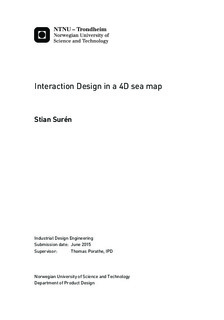| dc.description.abstract | Background
ROVs are becoming a huge part of the maritime industry today. As the industry is looking to exploit more of the subsea potential, ROVs are there to take on difficult tasks several hundred meters below sea level.
ROV missions become increasingly more complex, with several ROVs and vessels cooperating at great depths. The down time cost of an oil rig and the renting rates of subsea equipment makes ROV missions expensive. With a tightly planned mission, actors in the subsea market have a lot to save.
Objective
The goal has been to develop a concept for navigating virtual ROVs through a 3D representation of an actual subsea site. By saving the trajectories, the mission can be planned in detail. If the trajectories are realistic, then operations can be compressed to shorter periods of time. The time aspect is interactive, and is the fourth dimension of the sea map.
An important part was to research if an HMD such as the Oculus Rift could be used for such a purpose. An array of controllers were also tested.
Method
The thesis used a user centered design approach. User research, testing and depth interviews are the basis for the final concept. Users have been analyzed, and personas created as a result. The user journey has been visualized through scenarios. Functional prototypes created in the game development platform Unity have been widely used for user testing.
Result
Research showed that there is no industry wide standard to plan an ROV mission. Safety comes first, and there are many regulations aimed at standardizing safety procedures. ROV missions get delayed or cancelled by shifting weather conditions. ROV pilots need to have a well developed sense of direction, as they navigate in the darkness at great depths. It occurs that pilots lose their way in the deep, which is expensive.
The Oculus Rift has been tested. When effectiveness is measured, the test indicates a small improvement with the Rift compared to a regular computer screen as the user navigates a 3D-world. The drawbacks of using the Rift are discussed, and it is concluded that, at present time, the advantages do not overcome the discussed drawbacks.
Several controllers were tested. The PS3 controller and a regular gaming joystick are recommended as the best alternatives for navigating in the 3D world. For the sake of availability, keyboard controls are also proposed.
The result is a concept for a desktop application that enables ROV supervisors to plan an ROV mission by creating trajectories for the involved vessels and vehicles. Ocean current and the tether from the ROV is simulated to add realism. | |

